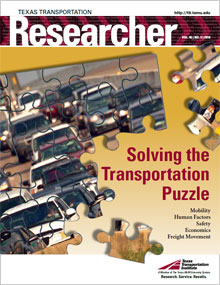
Consistency is an important principle in roadway safety. It ensures that roadways conform to recommended guidelines and promote safety to drivers. The Texas Transportation Institute (TTI) has developed the Radiusmeter to help improve consistency on horizontal curves.
“A large percentage of crashes occur on horizontal curves on two-lane highways,” says Paul Carlson, head of TTI‘s Operations and Design Division. “So we looked at ways to reduce crashes. TTI has done a lot of research in this area over the years, and we helped the Texas Department of Transportation [TxDOT] develop guidelines for how to sign and mark horizontal curves. The guidelines also help improve consistency across districts.”
The Federal Highway Administration (FHWA) later adopted similar guidelines and incorporated them into the national Manual on Uniform Traffic Control Devices. Some of the techniques described in the guidelines require knowing the radius of the horizontal curve. Traditionally, this has required survey crews, and the time and money to field them. The Radiusmeter does away with the need for a survey crew — again improving safety by not exposing crews to traffic.
“The research project by TTI shows the promise of a new procedure using available GPS [global positioning system] technology to adequately determine an appropriate radius for a horizontal curve and its associated advisory speed as an alternate to the current common method of the ‘ballbank’ indicator,” says Joe Toole, associate administrator of safety with FHWA.
The Radiusmeter sits on the vehicle’s dashboard and operates at normal traveling speeds. “It records the distance and direction of travel,” says Dick Zimmer, TTI senior research specialist, who developed the device’s hardware and software. “At the end of the curve, it computes the radius of the curve. It also shows the vehicle’s latitude and longitude.”
TTI developed the Radiusmeter for TxDOT and has provided units to the Minnesota Department of Transportation (Mn/DOT) and a private traffic engineering service in Australia (which asked for a metric version). TTI has also developed a software program to provide the same function using a laptop and standard GPS device.
Mn/DOT recently surveyed its districts about use of the Radiusmeter. “Compared to previous methods to determine curve radius, the Radiusmeters have proven efficient, reliable, easy to install, easy to use and collect data, and relatively safe for the user,” says Katie Fleming, a Mn/DOT research analyst.
According to Kevin Lavery, co-director of Australia’s Integrated Integrity Pty. Ltd., “The Radiusmeter is the most efficient instrument available for measuring the radii of highway horizontal curves.”
“An ongoing piece of work is developing an Apple app to work on the iPhone,” says Carlson. “The iPhone has built-in accelerometers and can measure the lateral acceleration in a curve. With this additional information, we can do more than just give the user the radius of the curve. The app is in final stages of testing and is envisioned to replace the ballbank indicator. Using the app and the Radiusmeter will give agencies new tools to uniformly sign and mark horizontal curves.”
Transportation safety — there’s an app for that!
